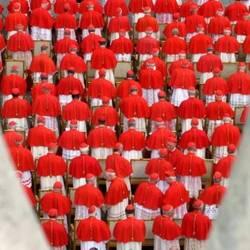|
Pope announces names of new cardinals: Only one Curia member, many pastors from the peripheries
By Andrea Tornielli
At today’s Angelus Pope Francis read out the names of 20 bishops and archbishops who will be raised to the dignity of the cardinalate at the upcoming Consistory on February 14th. 15 of them will be eligible to vote in a Conclave
Pope Francis has announced the names of the new cardinals who will receive the red biretta this coming February 14th. There will be 20 new “senators of the Church”, from across 14 nations and five Continents. 15 of them are under 80 years old and would therefore be eligible to vote in a potential Conclave. Five of them are over 80 . The new members of the College of Cardinals are as follows: Archbishop Dominique Mamberti, Prefect of the Supreme Tribunal of the Apostolic Signatura Archbishop Manuel José Macario do Nascimento Clemente, Patriarch of Lisbon (Portugal) Archbishop Berhaneyesus Demerew Souraphiel, C.M., of Addis Abeba (Ethiopia) Archbishop John Atcherley Dew of Wellington (New Zealand) Archbishop Edoardo Menichelli of Ancona-Osimo (Italy) Archbishop Pierre Nguyên Văn Nhon of Hà Nôi (Viêt Nam) Archbishop Alberto Suàrez Inda of Morelia (Mexico) Archbishop Charles Maung Bo, S.D.B., of Yangon (Myanmar) Archbishop Francis Xavier Kriengsak Kovithavanij of Bangkok (Thailand) Archbishop Francesco Montenegro of Agrigento (Italy) Archbishop Daniel Fernando Sturla Berhouet, S.D.B., of Montevideo (Uruguay) Archbishop Ricardo Blázquez Pérez of Vallodolid (Spain) Bishop José Luis Lacunza Maestrojuán, O.A.R., of David (Panamá) Bishop Arlindo Gomes Furtado, of Santiago de Cabo Verde (Archipelago of Cape Verde) Bishop Soane Patita Paini Mafi of Tonga (Island of Tonga) The five new cardinals who are over the age of 80, have “distinguished" themselves "for their pastoral charity in the service of the Holy See and of the Church,” the Pope said. He added that “they represent so many Bishops who, with the same pastoral solicitude, have given witness of love for Christ and for the people of God in particular Churches, in the Rome Curia, and in the Diplomatic Service of the Holy See.” They are: José de Jesús Pimiento Rodriguez, Archbishop Emeritus of Manizales Archbishop Luigi De Magistris, Major Pro-Penitentiary Emeritus Archbishop Karl-Joseph Rauber, Apostolic Nuncio Luis Héctor Villaba, Archbishop Emeritus of Tucumán Júlio Duarte Langa, Bishop Emeritus of Xai-Xai Francis seems to have respected the unwritten rule of not creating the current archbishop of a see with a retired cardinal under 80 years of age, a cardinal. Potential US candidates in Los Angeles, Philadelphia and Chicago will not therefore be receiving the red biretta and neither will the new Archbishop of Madrid.
Dominique Mamberti, the new Prefect of the Apostolic Signatura, is the only Curia member appearing in the list of new cardinals. The Vatican’s former “minister of foreign affairs” was not yet a cardinal when he carried out the only role within a Holy See dicastery where the title of cardinal is a given(as established in John Paul II’s Apostolic Constitution “Pastor Bonus”).
None of the Pontifical Council presidents are to be created cardinals. Pontifical Councils are not ordinarily presided over by cardinals (except in the case of the ecumenism council led by Kurt Koch) and are going to be merged as part of the Curia reform process currently underway. The Librarian of the Holy Roman Church, the Frenchman, Jean-Louis Bruguès, did not feature in the list of cardinals-to-be either. Francis’ preference for diocesan bishops is therefore evident, as well as his focus on the southern parts of the world. With today’s list, Francis repeats a decision he took during the Consistory in February 2014, which is not to automatically name cardinals the archbishops of certain sees considered "cardinalatial sees". According to another unwritten rule, the archbishops of these sees were traditionally created cardinals at the next possible Consistory. Benedict XVI had already begun to stray from this unwritten rule, making the heads of Italian dioceses wait, when in the past they would have received the red biretta even if their predecessors had not reached the age of 80. Today’s list shows that Francis is continuing along this line both with regard to Italian “cardinalatial sees” and foreign ones, choosing to bring pastors from other dioceses in to the College of Cardinals. Two examples are the Italian Archbishops of Ancona and Agrigento, Edoardo Menichelli and Francesco Montenegro respectively. In fact, of the list’s 14 new cardinal electors who are heads of dioceses, as many as 9 are pastors of local Churches that have never had a cardinal (David, Valladolid, Morelia, Ancona, Agrigento, Tonga, Santiago de Cabo Verde, Yangon) or have not had one for decades, Montevideo for example.
|
.
Any original material on these pages is copyright © BishopAccountability.org 2004. Reproduce freely with attribution.
